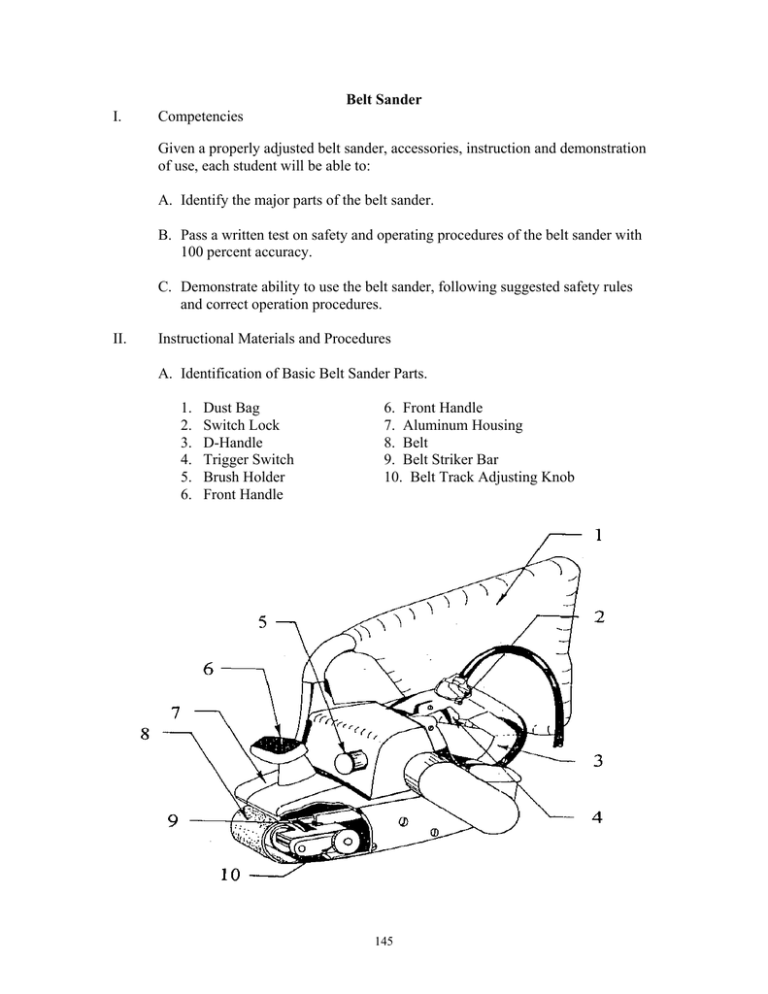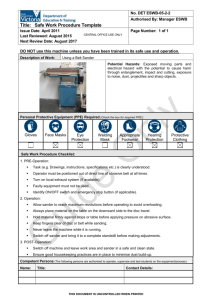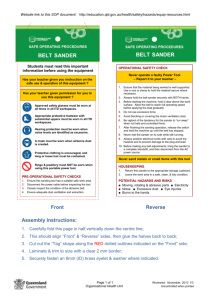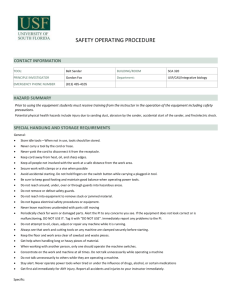Belt Sander Safety
advertisement

Belt Sander I. Competencies Given a properly adjusted belt sander, accessories, instruction and demonstration of use, each student will be able to: A. Identify the major parts of the belt sander. B. Pass a written test on safety and operating procedures of the belt sander with 100 percent accuracy. C. Demonstrate ability to use the belt sander, following suggested safety rules and correct operation procedures. II. Instructional Materials and Procedures A. Identification of Basic Belt Sander Parts. 1. 2. 3. 4. 5. 6. Dust Bag Switch Lock D-Handle Trigger Switch Brush Holder Front Handle 6. Front Handle 7. Aluminum Housing 8. Belt 9. Belt Striker Bar 10. Belt Track Adjusting Knob 145 B. Belt Sander Safety 1. Wear safety glasses at all times when using the belt sander. 2. Wear hearing protectors and a dust mask when belt sanding. 3. Check the electrical cord and its connection to the sander housing for cuts, frays, or exposed wires. Exposed wires should be repaired before using the sander to avoid electrical shock or damage to the sander. 4. Keep both hands on the belt sander at all times when sanding. 5. Keep the electrical and extension cords away from the sanding area to avoid being cut by the rotating sanding belt. 6. Do not over-extend and lose balance when using the belt sander. 7. Raise the belt sander of the work, turn the switch to ON, and lower the Belt Sander slowly onto the surface being sanded. 8. Place the sander on its side when not in use to prevent it from being accidentally or intentionally turned on and running off the table. 9. Always clamp the material being sanded securely before starting the belt sanding operation. 10. Always unplug the belt sander when the sanding is completed or if you are leaving the sanding area. C. Operating Procedures 1. To change the sanding belt hold the belt sander in a vertical position, push down on the front belt roller until it catches. Slide the old sanding belt off and observe the direction of the arrow on the inside of the old belt. Put the new belt on with the arrow pointing in the same direction as the arrow on the old. Release the catch on the front roller to apply tension to the new belt. 2. Empty the dust bag often for most efficient operation. 3. Before using the belt sander turn it on and adjust the belt tracking so the belt runs true on the front and rear rollers. Slight tracking adjustments may need to be made during the sanding operation. 146 4. Move the sander back and forth in smooth even strokes along the direction of the wood grain. Keep the sander moving at all times to avoid sanding uneven spots in the wood. 5. Start the sanding operation with a course grit sand belt, then move to a medium grit belt, and finish the operation with a fine grit belt. 6. When finished sanding lift the belt sander off the material and then release the Off/On switch. 7. Lay the belt sander on its side when setting the tool down. 8. When sanding do not allow the belt sander to extend over the ends of the material. This will prevent uneven amounts of material from being removed at the ends. 147 III. Written Test Belt Sander Safety and Operation Name__________________________ Date_______________ Class________________ Multiple Choice - Place the letter of the most correct answer on the answer sheet. 1. What personal protective equipment should be worn when using the belt sander? a. b. c. d. Safety glasses Safety glasses and hearing protection Safety glasses, hearing protection, and a dust mask Safety glasses, hearing protection, dust mask, and gloves 2. How should the belt sander be placed when setting it down after sanding? a. b. c. d. On its side On its Belt In a belt sander stand Either a or c 3. If the belt sander operator exits the sanding area, what should he/she do before leaving? a. b. c. d. Put the sander on the floor. Place the sander in a sander stand. Lock the sander trigger switch. Unplug the belt sander. 4. To loosen the sanding belt when changing the sanding belt the operator ___________ to loosen the old belt. a. b. c. d. moves the belt striker bar move the belt track adjusting knob pushes down on the front belt pulley pushes down on the rear belt pulley 5. To avoid uneven sanding spots in the wood the belt sander operator should __________. a. b. c. d. hold up on the belt sander. move the sander back and forth in smooth even strokes. move the sander rather fast. apply only light down pressure when sanding. 148 6. When the sanding operation is completed the operator should _____________. a. b. c. d. turn off the belt sander immediately. let the sand belt come to a stop while resting on the wood. pullout the electrical cord. raise the sander off the wood and allow the bet to come to a stop. 7. If the belt sander extends over the end of the material while it is being sanded it will ________________. a. b. c. d. cause no harm. remove an excessive amount of material from the end. cut and break the sand belt. cause the sand belt to need a track adjustment. 149 IV. Performance Test for the Belt Sander The student performs the following while operating the belt sander. Yes 1. Safety glasses are worn while the sander is being used. ___ No ___ N/A ___ 2. Hearing protectors and gloves are worn when the portable belt sander is being operated. ___ ___ ___ 3. The belt sander is held firmly in both hands as the switch is turned on. ___ ___ ___ 4. The portable belt sander has stopped rotating before it is laid down. ___ ___ ___ 5. The electrical and extension cords are positioned away from the work being performed. ___ ___ ___ 6. When the sanding belt is replaced on the portable belt sander the electric cord is unplugged. ___ ___ ___ 7. The student can remove and replace the sanding belt on the belt sander. ___ ___ ___ 9. The student can safely control the belt sander and perform satisfactory sanding work. ___ ___ ___ I do hereby certify that the student has satisfactorily demonstrated ability to operate the belt sander by passing this performance test. _____________________ Student ______ Date 150 _____________________ Teacher ______ Date Belt Sander Parts Identification Test Name_____________________________ Match the number of each belt sander with the correct part name. ___ A. Aluminum Housing ___ B. Belt ___ C. Belt Striker Bar ___ D. Brush Holder Belt ___ E. D-Handle ___ F. ___ G. ___ H. ___ I. Dust Bag Front Handle Switch Lock Track Adjusting Knob ___ J. Trigger Switch 151 149 150 151



